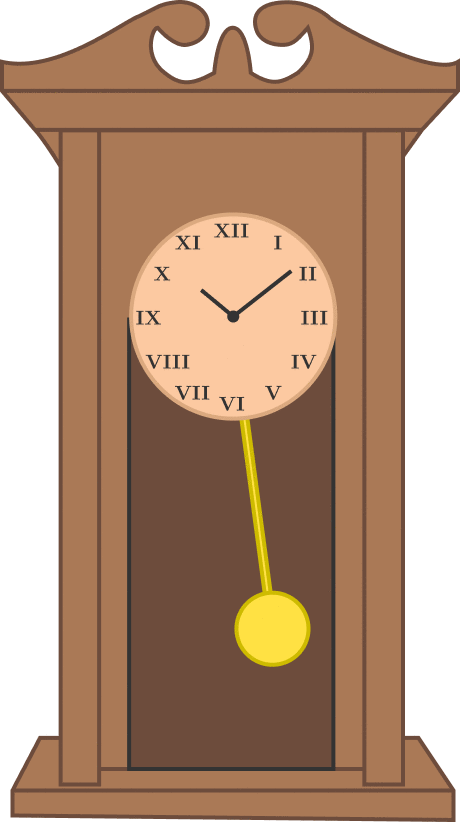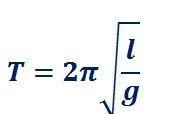Pendulum clocks

A pendulum clock uses the oscillations of a pendulum, a swinging weight, to keep track of time. When the temperature rises and the length of the pendulum increases, what will happen to the clock?
Details and Assumptions
- Ignore the effects of air resistance.
This section requires Javascript.
You are seeing this because something didn't load right. We suggest you, (a) try
refreshing the page, (b) enabling javascript if it is disabled on your browser and,
finally, (c)
loading the
non-javascript version of this page
. We're sorry about the hassle.
13 solutions
I thought inside the chamber is vacuum, so the pendulum can swing forever.
Log in to reply
Sadly, no. Pendulum clocks are a fairly old invention, they didn't have the technology to create a vacuum inside a wooden box. :) And the pendulum would not be able to swing forever in a vacuum: even with the air resistance (mostly) gone, the pendulum would still translate some of its kinetic energy to the clock, in order to move the arrows. So it would still gradually become slower and slower, although the vacuum would most likely make it last longer, I believe.
Wow, so how come this kind of ol' clock can work for such like, 20 years? Thanks for your explanation, so I just think about the thermal expansion of the rod.
Log in to reply
Clocks can remain workable for a long time depending on quality of craftsmanship but they still have to be manually wound, perhaps once a week or so.
Even in side a vacuum chamber the clock will be slower , because heat is an electromagnetic wave and can travel through vacuum
The angle the rod travels through remains constant independent of thermal expansion. If anything the rod being longer should cause the angular velocity to increase and cause the clock to "tick" faster.
Log in to reply
If we conserve the angular momentum ( I ω ) of the rod about the hinge point, the longer pendulum will have greater moment of inertia ( I ) and smaller angular velocity ( ω ).
If you think about this in terms of conservation of energy, the pendulum swings such that it achieves Vmax at the midpoint (this is all kinetic energy = .5 m x Vmax^^2) and then swings in an arc "upward" and stops (momentarily) when its potential energy, mgh (where h is height above the midpoint) matches its kinetic energy at the midpoint.
When the pendulum gets longer without change in mass, then Vmax must stay the same since KE is proportional to Vmax^^2.. However, the longer pendulum must draw out a longer arc in order to achieve the same value of h (potential energy) when it comes to a stop. So Vmax is constant, but the longer arc means its angular velocity is reduced, as noted in another Reply, and so it takes a little longer to get there/runs slow.
Of course, if the increase in arc length causes the pendulum to smash (frictionless) into the sides of the clock-case, then who knows...??
What about mass? Shouldn't the pendulum's mass be also increasing with thermal expansion? If so...the period won't be slightly smaller keeping the speed of the clock basically the same as before? Thanks in advance
Log in to reply
The mass of pendulum doesn't change the period.
Thermal expansion does not change the mass of the bob, it may change its size.
Your argument makes sense if the pendulum winds a mainspring; if on the other hand it’s connected to a gear chain wouldn’t pendulum elongation create greater leverage causing the gears to move faster?
But the air density will be lower allowing the pendulum to move easier / faster due to less resistance
Log in to reply
The air resistance force depends on the speed with which the object moves. Compared to the gravitational force, drag force is very weak (at the speed at which the pendulum moves).
The time period of pendulum is
 from this we can see as the length increases the time period also increases. Initially let the time period be 1 second after the length is increased assume the new time period is increased to 2 second so for covering the same distance pendulum is taking twice the time hence it moves slowly.
For further information
click here
from this we can see as the length increases the time period also increases. Initially let the time period be 1 second after the length is increased assume the new time period is increased to 2 second so for covering the same distance pendulum is taking twice the time hence it moves slowly.
For further information
click here
I had forget this mathematical formula。 what a shame...
Matt Parker (standupmaths on YouTube) used this formula to calculate pi using a pie
On increasing temperature LINEAR THERMAL EXPANSION of rod takes place due to which effective length of pendulum increases and as a result time period of oscillation increases
pendulum lenght increases oscillation SLOWS down so clock runs slow.
My grandparents had a pendulum, I thought nothing ever happened when it go hotter, it seemed to swing always the same way. I don't understand what oscillation means. I would rate this problem a 6 because it's quite confusing. I didn't really understand what the question meant. It seemed like the answer was obvious.
Moving at the same speed, a longer pendulum has more distance to cover than a short one, so it will take longer to cover the distance.
Thats what makes sense to me, thanks :)
The time period of a pendulum is given by T=2π√(L/g). Where L and g are length of pendulum and gravitational acceleration respectively. If the temperature increases, length of pendulum will also increase because of thermal expansion. And so it's time period will increase. That's why clock will slow down.
Just think what happens when we pull a rope with a weight swinging on it and that is hanging on a tree limb. The pulling movement shortens the hanging rope and the swinging movement becomes faster. The contrary happens when we let some rope loose. That happens also with hanging pinhatas.
The rod as well as the bob that made up the pendulum has been perfectly calibrated for length and weight. Any change or variation in the environment that could result in modifying linear dimension by elevation of temperature or changing weight by effect of gravity will result in specific changes in the length of swing or oscillation, thus changing the length of the unit of time . T = 2π√L/G.
Since T proportional to √l ,so temp.rise will lead to linear thermal expansion i.e. increase in l =>Time period of oscillation increases hence it will cause the clock to lose time.
Because the rod is getting longer, it is getting heavier which causes the rod to move slower.
How can mass increase? from where will it come? it will be created by heating?😂😂😂😂😂😂 take a look at conservation of mass
Yes, it doesn't get heavier like Bibhu Biswajit has mentioned
Heating does not change the mass of the pendulum. The volume will increase and the density decreases. Moreover, the time period of a pendulum does not depend on the mass of the pendulum, it only depends on its length.
Time period of pendulum = 2π √l/√g Where l is it's length and g is acceleration due to gravity We can see T^2 is directly proportional to length As length increases time period increases and it runs slower
As the length of the pendulum increases, so does its oscillation time. So because it takes longer to do an oscillation, it will take longer to measure time, thus giving it the appearance of occurring at a slower rate.
as the temperature increase the length of the rod increases and T is prop. to root L . So now the clock's "second" hand moves after time more than one second hence after some time there is fair difference in time between regular clock and our pendulum clock.
By incresing temperature it is obvious that the lenght of pendulum will increase too and so the period.
Clockmakers try to compensate this effect by using for the lentil at the end of pendulum a material with a dilatation coefficient higher than the pendulum ideally with ratio L/D.
Being L the lenght of pendulum and D the diameter of lentil. Now if you allow the lentil moving just upwards freely it will compensate somehow the temperature increase, since center of mass remains at same distance from oscillation point.
Probably you have noticed there is a screw at the botton of pendulum, for a fine adjustment of period and to allow the lentil which rest on it to move upwards , as said above.
Increasing the temperature will cause the length of the rod to increase. This is due to thermal expansion — the tendency of matter to increase in shape, area, and volume as temperature increases. As the length of the pendulum rod increases so does its period of oscillation. The higher the temperature, the slower the clock will tick.
Since wood expands less than metal, some clocks have wooden pendulums to reduce the impact of thermal expansion.